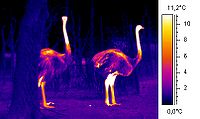
Photo from wikipedia
Terestrial isopods have evolved adaptations to reduce water loss, which is necessary for life in low humidity environments. However, the evolution of a waterproofed cuticle to prevent loss of water… Click to show full abstract
Terestrial isopods have evolved adaptations to reduce water loss, which is necessary for life in low humidity environments. However, the evolution of a waterproofed cuticle to prevent loss of water to the environment could also impede oxygen uptake from the environment. We therefore postulate an evolutionary trade-off between water retention and gas exchange in this group of soil animals. The outcome of this trade-off is expected to be affected by both differences across species (different types of lung) and differences within species (body size and resulting surface area to volume ratio's). To test these ideas we compared two sympatric isopods: Porcellio scaber and Oniscus asellus. While P. scaber possesses covered lungs typical for drier habitats, O. asellus has simple open respiratory fields which are in direct contact with the external air. For each species, we assessed how individuals across a broad range in body size differed in their hypoxia and desiccation tolerance. In addition, we assessed how hypoxia and low humidity affected their thermal preference. We found clear effects of species identity and body size on tolerance to hypoxia and low humidity. Desiccation resistance was tightly linked to water loss rates (R2=0.96) and strongly resembled the interspecific pattern across 20 isopod species. However, our results did not support the postulated trade-off. Tolerance to hypoxia and low humidity covaried, both increasing with body size and being higher in P. scaber. Thermal preference was affected by both hypoxia and low humidity, but not by body size. Our study increases our understanding of the ecophysiology of both species, which can be useful in explaining the geographical distribution and use of microhabitats of isopod species in a climate change context.
Journal Title: Journal of insect physiology
Year Published: 2021
Link to full text (if available)
Share on Social Media: Sign Up to like & get
recommendations!